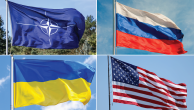In the third quarter, some patterns among different media sectors and outlets continued to reveal themselves. One such pattern is the basic similarity in the news judgment on the three nightly commercial broadcast network newscasts.
From July through September, the lineup of the top four stories—the Iraq war policy debate, followed by events inside Iraq, the presidential campaign and the U.S economy—was the same on ABC, NBC, and CBS—with just one exception. CBS had the events on the ground in Iraq narrowly ahead of the policy debate.

PBS’s nightly NewsHour also had the same list of top four stories, with one notable distinction. The program devoted much more time to its No. 1 story, the policy debate. It filled 23% of the newshole on the first half hour of the NewsHour. Of the three commercial broadcast networks, by comparison, the highest total for the Iraq debate was 8% on ABC. When all three threads of the Iraq war are combined—policy debate, events on the ground and homefront, PBS filled almost twice as much of its airtime (33%) with war-related coverage than the next closest commercial network, CBS (at 17%). (It’s worth noting that the hour-long PBS broadcast has an extra 30 minutes to devote to news each evening.)
When it comes to cable news, there tends to be considerably more variation in story selection.
In the third quarter of 2007, the third-biggest story on CNN was the ultimately unsuccessful effort to save the six men trapped in a Utah mine cave-in. The saga filled 6% of the cable network’s airtime for the three months. On the Fox News Channel, the mine disaster was a less newsworthy event and finished as the eighth-biggest story of the quarter, at 2% of the newshole. On MSNBC, the tragedy got even less attention, finishing out of the top-10 story list at 2%.
There was general agreement among the three cable nets about the top two stories of the quarter—the presidential race and the Iraq policy debate. (Although CNN was the only one to devote more coverage to the war debate rather than the campaign). But on other stories, the cable rivals made some very different coverage choices.
The oldest of the three cable news operations and the one with the broadest global reach, CNN devoted the most coverage to events inside Iraq (4%), its fifth-biggest story of the year. It was also the only one of the three cable competitors to include the recalls of pet food and Chinese products among its top 10 stories, at 2%. Given Lou Dobbs’ constant attention to the subject, immigration, the fourth-biggest story at 6%, is a bigger subject on CNN than either of its two competitors.

The Fox News Channel, which according to one’s viewpoint either tilts to the right or is a refreshing antidote to predominant liberal bias, devoted more coverage than its rivals to two threats to U.S. national security. Domestic terrorism issues were No. 3 at 5% and the simmering tensions between Iran and the U.S. were the sixth biggest story at 4%. It also devoted more airtime than CNN and MSNBC to the two big celebrity crime cases. O.J.’s run-in with the law was the fifth biggest at 4% while Michael Vick’s dogfighting bust, at 2%, was the tenth-biggest story.
For the third quarter in a row, the Fox News Channel also devoted less time to the Iraq war than CNN and MSNBC. When the three war threads—the Iraq policy debate, events inside Iraq, and the war’s impact on the homefront—are combined, 11% of Fox’s airtime was devoted to the war in the third quarter. That compares with 17% at CNN and 19% at MSNBC.
MSNBC, which promotes itself as a source for political news—“the place for politics” is one of its slogans—and has more implicitly acknowledged efforts to develop a more liberal prime-time lineup (they were interested in giving Rosie O’Donnell a show), showed that its marketing is also backed up by its story selection. It easily devoted the most airtime to the campaign (19%), compared to 11% at Fox and 7% at CNN. MSNBC also provided more coverage to Larry Craig (No. 3 story at 5%), the Valerie Plame outing case that resulted in the conviction of Scooter Libby (No. 6 at 3%), the resignation of Attorney General Alberto Gonzales (No. 8 at 2%) and the resignation of Karl Rove (No. 10 at 2%) than either of its competitors.
Moreover, MSNBC front-loaded heavily on its two top stories. Combined, the presidential campaign (19%) and the Iraq policy debate (18%) filled 37% of the network’s overall newshole in the quarter. At CNN, it took the top six stories combined to fill 37% of the newshole and on Fox, it took the top seven stories to reach that level.
The trend was even more pronounced on prime time, where the top issues of the day are dissected and discussed. At night on MSNBC, the Iraq debate and the race for the White House accounted for 45% of all coverage. On Fox, those two subjects accounted for about half as much coverage, 22%. On CNN, the war debate and campaign accounted for one-fifth of all of that network’s coverage, at 20.
In the world of radio news and information, the type of platform made a difference. While NPR’s “Morning Edition” and the ABC and CBS radio headlines both made the Iraq policy debate the top story, talk radio devoted the most time to the presidential campaign. (The 2008 race was only the 11th biggest topic on the headline services.) Meanwhile, talk radio’s third-hottest subject, the Larry Craig scandal, was No. 7 in the headlines and not even among “Morning Edition’s” top 20 stories of the quarter.




